
Photo: Lindi Botha
In a unique laboratory in Letsitele, Limpopo, a team of technicians is quietly at work creating what will grow to become South Africa’s entire banana crop.
The process seems more related to medical science than agriculture: the employees, wearing face masks and gloves and wielding scalpels, work in an ultra-sterile environment, slicing and duplicating banana tissue culture as the first step to producing a high-yielding, disease-free banana plantation.
The plants are produced in Du Roi Laboratory through rapid multiplication of tissue culture, which offers farmers the benefit of converting or expanding plantations quickly and efficiently with superior selections of plants that are true to type.
“The benefit of tissue- cultured plants is that they are uniform, so they grow at the same pace and are ready to harvest at the same time. It makes management of the plantation that much easier,” says Suné Wiltshire, the laboratory’s general manager.
Where it all begins
The starting point is a 4ha mother block, established for many years, that includes the varieties proven to possess the best characteristics. This is crucial, says Wiltshire, as the tissue culture process is a clone of the mother plant.
“What you put in, you get out. When we select for commercial plants, we look for a faster cycle, a more cylindrical bunch and a shorter plant that is easier to manage. All our mother plants need to have these traits so that the suckers we multiply using the tissue culture process have them too.”
Suckers are taken from the mother blocks to the laboratory, where they are dissected into smaller pieces and placed in small tubs in growth hormones to encourage them to multiply faster.
The tubs are then placed in growing rooms where temperature, light and humidity are controlled to produce an ideal growing climate.
After four weeks, the tubs are returned to the laboratory, where the plants are dissected further. The staff, working with scalpels and tweezers, never touch the plants with their hands.
“During all the dissecting stages, it’s important that each piece still has a part of the original growth point, known as meristematic tissue, or the plant will not make more shoots,” Wiltshire explains.
This dissection and multiplication is repeated five times over a period of five months to obtain 2 000 plants from the single original sucker. According to Wiltshire, it is important to stop the multiplication process at this point.
“The potential of tissue culture is exponential because it can keep multiplying, and we can end up with as many as 100 000 plants if we go to a sixth or seventh round. But this also increases the risk of mutation. By stopping at round five, we maintain less than 1% mutation, making it a highly stable plant.”
The last step is to stop the vegetative growth and stimulate the plant to focus on root formation. The team therefore applies a rooting hormone, and after four weeks transplants the plants into trays and places them in automated greenhouses to grow each plant to the 5cm stage. The plants are then planted out in the nursery, where they undergo vigorous growth.
After six to eight weeks in the nursery the plants reach 20cm and they are then ready to be planted in the land.
Tested for viruses
With concern growing over the spread of Panama disease, it is imperative that the laboratory can guarantee disease-free banana plants. Each meristem is therefore tested for all known banana viruses before multiplication.
“Even though South Africa does not have Panama disease and it can’t be transferred through the tissue culture process as it’s a fungus, we still include it in our test to give our clients peace of mind. It’s also important to test every single sucker because the mother tree can sometimes be disease-free while the daughter is not,” says Wiltshire.
The laboratory employs nearly 150 people and produces approximately 10 million banana plants annually. The process of multiplying the suckers requires steady concentration, and the women therefore work in two four-hour shifts, with a four-hour break in between.
It takes about six months for new employees to master the multiplication technique and reach their target of producing 3 500 plant multiplications per day across the two shifts,
or 1 800 pieces that have been rooted and graded according to size.
The latter is a longer process as it includes the first grading of the plant, which involves the workers having to select the best plants conforming to strict quality protocols.
Each tub with dissected plants has a sticker that corresponds with a certain plant in the mother block. This ensures that should there ever be a problem with a plant, it can be traced back to the exact batch.
The market
Du Roi exports its plants to 25 countries in Africa, the Middle East and the French West Indies. Approximately 25% are supplied in vitro, at about 2,5cm in height, in a grower tub containing 55 plants.
This makes for a convenient air freight package, as a large number of plants can be transported while taking up minimal space.
“Growers must be geared for weaning the plants as they can’t go directly into the land at this young age. The plants must be grown out in a greenhouse over 12 weeks,” Wiltshire says.
The plants can also be bought at the in vivo stage; these have already been weaned and are about 5cm tall. These plants can be planted out under a shade net and they will be land-ready after six to eight weeks. Land-ready, 20cm-tall plants can also be bought for direct planting.
South African farmers make up the majority of the company’s clients.
“The benefit of growing bananas is that you get a harvest in the first year so it’s a good cash crop,” says Wiltshire. “As the culturing process takes six months for an in vitro plant, eight months for an in vivo plant and 10 months for a land-ready plant, it’s important for us to gauge the market to ensure we always have stock.”
Farmers replant their plantations every seven to 10 years.
“The plants reach peak production at some point and then taper off. So the farmer needs to do a cost analysis to determine when it’s no longer financially viable to continue with the plantation, but rather replant it.
“Some farmers replant every year. Because of the added benefit of uniform trees that are ready for harvest at the same time, planting trees produced from tissue culture provides a substantial incentive for farmers to replant their plantations annually.”
Phone Du Roi Laboratory on 015 345 1217, or email [email protected].











